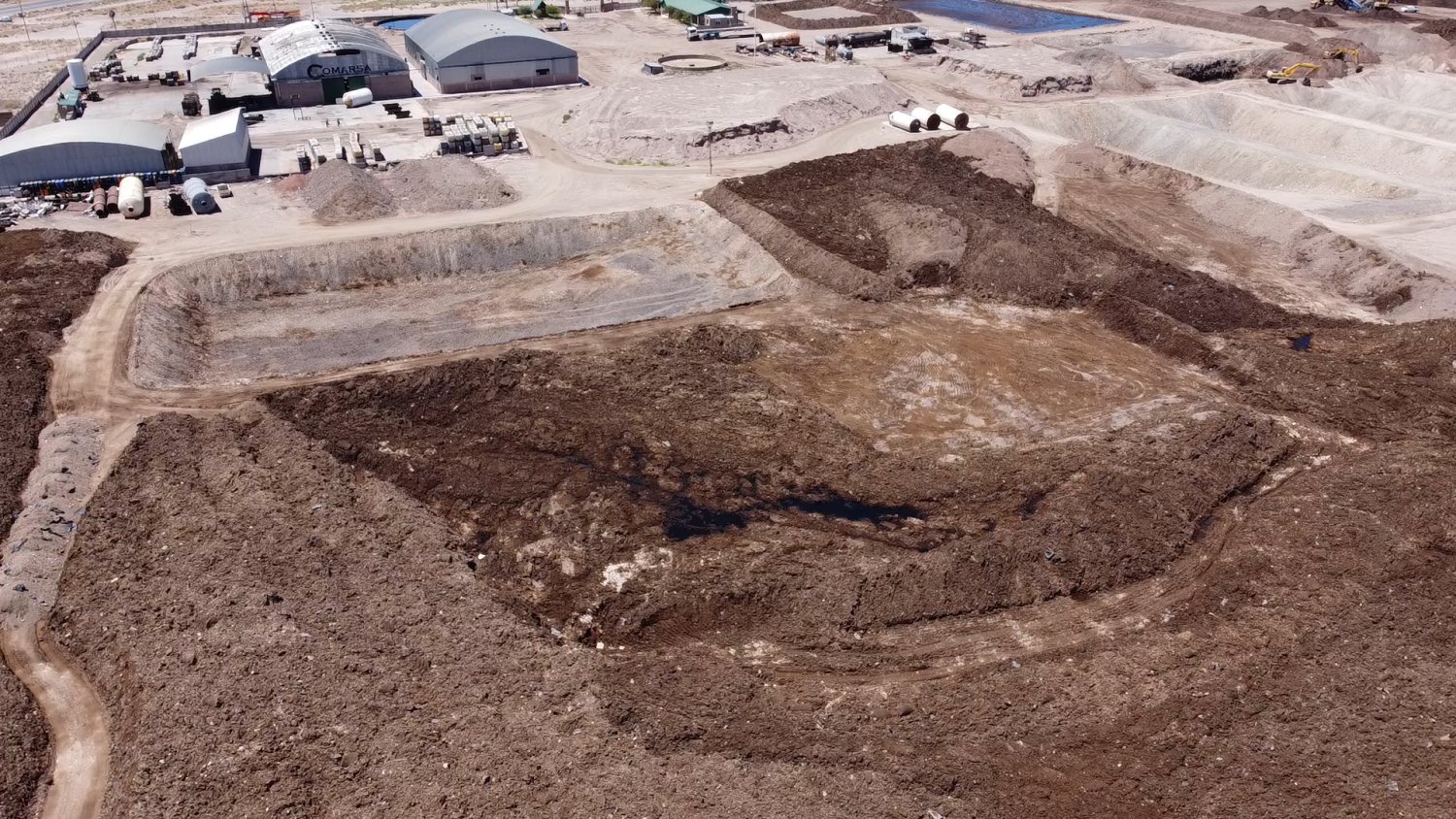
The Municipal Institute of Urbanism and Habitat (IMUH) of Neuquén capital will deliver on September 18 more than 360 plots in District 6, located on the side of the northern highway (new route 22), between the mountain of polluting waste from Comarsa and Casimiro Gómez Avenue.
As soon as the successful bidders take possession of the site, they will be able to request electricity reductions, water supply, and home gas and electricity connections in order to begin construction.
This is what happened with the first subdivision with services, District 7 (869 lots) located on the opposite side of Casimiro Gómez Avenue. In less than four months, the construction sites and fences changed the view on the new route 22. But, unlike their neighbors, the new owners of District 6 will have to living with a mountain of mud with hydrocarbons that were deposited in the place without treatment.
The Comarsa businessmen are facing criminal charges for pollution and fraud, because they charged millions of dollars for collecting hazardous waste knowing that they would not be able to work with it, according to the Environmental Crimes Prosecutor’s Office in the investigation.
While the process reaches trial, the firm and the owners were seized for a $7 million bond.

Who will remove the mountain of contaminated sludge from the site is a question that remains unanswered. More than 10,000 trucks will be needed to remove some 300,000 cubic meters of oil-laden sludge..
The prosecution also demands that the transfer of the material to the new plant involves the treatment of the product and the soil sanitationbecause it maintains that there was no waterproofing of the land where the sludge was deposited.
Part of Soldi Street, which runs to District 6, is blocked by the mountain of pollutants, as the company continued to receive more waste than the perimeter allowed.
The current enclosure of the mountain of mud that came from the oil wells includes the public street that the city claims.
The criminal case will establish responsibilities, but will not define what will happen to the pollutants in the place that, in a month, will begin to be urbanized with new housing.
When the prosecution and the complaints They asked Judge Mauricio Zabala to warn the municipality about the content of that mountain of pollutants and the potential danger of cohabitation with human beings, the judge said the request exceeded the scope of the hearing to formulate charges.
He assumed that the municipality would have environmental studies to move forward with the infrastructure works that were more than 70% complete in the subdivision.
The environmental lawyers’ complaint proposed issuing a precautionary measure to allow the provincial Environment Department to intervene, but the judge insisted that this exceeded the scope of the criminal investigation.
It was felt that the industry’s liabilities should be addressed by the police power.
“We had meetings with the provincial Environment Department and the Ombudsman asked us to do a Study of the quality of air and soil closest to Comarsawhich gave us good results; with recommendations from professionals to make a green bellows,” said Marco Zapata, president of the IMUH. Based on these results, the urbanization in the surroundings of Comarsa continued its course.
Regarding the proposals of the Environmental Crimes Prosecutor’s Office to not build urban settlements within 1,000 meters of the mountain of pollutants, Zapata said “there is a decree that speaks of more than 5,000 meters and we have half of Neuquén city in that area, that must be relocated and we ask that the situation be resolved soon,” he said.
“The Comarsa case is not only about economic fraud for charging for something that was not rectified; future generations are affected here and that is why the judge was asked to let the mayor and the governor know what is happening, to tell society what is happening,” explained lawyer Bruno Vadalá, of the APDH complaint.

From the Ombudsman’s Office, Deputy Emmanuel Guagliardo met with the municipality, environmental authorities of the province and the IMUH.
Guagliardo said that if the trial leads to a conviction, “that does not remove the problem of what to do with the waste that is there today.”
He added that the polluting waste must be removed from the site “which is related to the environmental liabilities of the industry. The State must ensure that the (oil) sector assumes this responsibility with the residents,” he said.
He stressed that the municipality created a process of access to housing “which has an obstacle with the Comarsa case, that is what we have to articulate between the municipal and provincial State, a solution that has to do with the withdrawal and sanitation, where the resources must come from the oil industry,” he insisted.
He said that “mobilizing these resources is an enormous budgetary effort that neither the province nor the municipalities can make.”
The Ombudsman requested a meeting with the Ministry of Energy and Environment. “There must be a solution to this issue, we must consider how to resolve it with the operators: I trust that the oil operators will be required to assume their responsibility for this liability of the industry and take charge of this waste,” he said.

The responsibility of removing the waste and the action of justice
The provincial environmental crimes prosecutor’s office has requested that the waste that the company Comarsa has assured the province it will remove be treated.
When prosecutor Maximiliano Breide Obeid asked in the first months of the year that there be no urban development around the mountain of pollutants, he was denied a hearing.
Then there was a meeting with the municipality in which there were also no coincidences regarding the results of the environmental studies. After the meeting with the Ombudsman’s Office, the province, through the Environment Department, submitted a plan by the businessman to remove the contaminating waste. The prosecutor’s office recalled that Héctor Basilotta had previously said that he was going to remedy the mud and did not comply with the plan.
It was indicated that, if the mountain of sludge is to be removed (which is part of the evidence in the case), it will be authorized after treatment and with weekly verification of the work. The concern is that a plan was presented for removal and not for sanitation of the place that will be part of the public land for new subdivisions and a street.
Leticia Esteves will follow the case of the treatment plant and the new subdivision
The Secretary of Planning and Institutional Relations of the province, Leticia Esteves, was appointed as the Secretary of Environment of the province.
The position was held by Santiago Nogueira, who had the first meetings in May with the Ombudsman of Neuquén regarding the contaminants left by Comarsa next to District 6 and other urbanizations such as Loteo Social, 7 de Mayo, El Nido, the Espartanos occupation, Mapu Neu or the cattle ranching families of the old Carola post, all with the last name González.
Esteves took office in July and Nogueira was named Undersecretary for Climate Change, both agencies under the Ministry of Energy and Natural Resources.
It was clarified that Esteves will continue to be in charge of the Planning and Institutional Relations Secretariat of the Cabinet Office, on an “ad honorem” basis. The deputy in the Ombudsman’s Office, Emmanuel Guagliardo, assured that in a few days he will try to resume the meeting with the environmental portfolio on the issue of the sludge mountain.
Among the proposals to the province, Guagliardo asked to know the plan for reducing the volume of special waste, the rehabilitation of the site and the monitoring of hazardous waste deposited on the property occupied by Comarsa. He asked to know the mitigation measures to “minimize the harmful effects and negative impacts” produced by the storage of “hazardous waste from the oil industry” with poor treatment.
He requested that relevant data be available “in order to guarantee the right to environmental information required by the population and the Ombudsman’s Office.”
*Article originally published in Diario Río Negro
Source: www.laizquierdadiario.com

